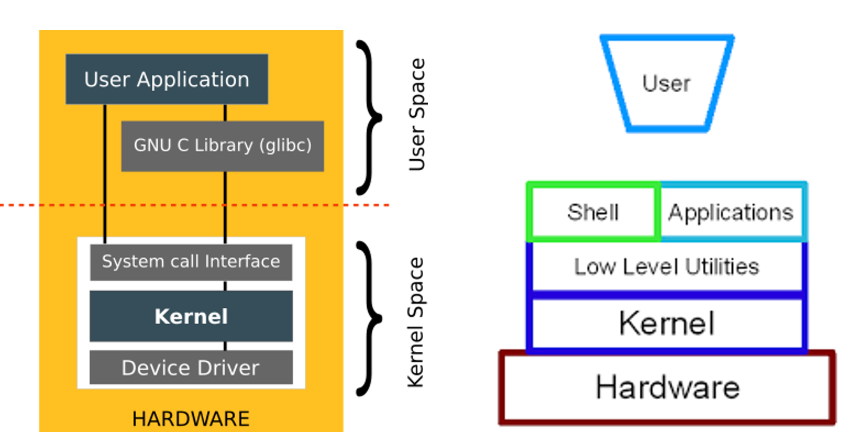Kernel¶
운영체제 중 항상 메모리에 올라가 있는 운영체제의 핵심 부분
H/W(하드웨어)와User program(or application, app) 사이에서User program(or application) 수행에 필요한 여러 서비스를 제공하기 위한 인터페이스를 제공- 컴퓨터 H/W (CPU, Memory)의 resource(자원)들을 관리
다음 그림은 Linux Architecture로 Kernel이 OS에서 어디에 위치하는지를 보여준다.

The kernel is the core of an operating system that
- manages system resources and
- provides services to applications and user processes.
It is responsible for managing the computer's memory, input/output operations, and scheduling of processes.
The kernel also serves as a bridge between the hardware and software components of the computer system.
Without the kernel, the computer system would not be able to function properly.
컴퓨터 H/W resource에 대한 interface 제공.¶
Kernel은 User program과 H/W resource 사이에서 이들을 연결 해주는 역할을 수행함.
- User program은
system call을 통해 kernel에 필요한 H/W resource의 사용을 요청하며, - Kernel은 이를 받아 해당
H/W resource에게 해당하는 명령을 전달하여 작업을 수행하고, 그 결과를 user program에 반환해줌.
User program은 Kernel이 제공하는
system call interface을 통해 computer의 physical resource를 사용 하게 됨.
- User programs와 Kernel 의 대화는
system call이라는 단일 인터페이스가 제공되는 것과 달리,- Linux가 제공하는
System call은 CPU architecture에 따라 다르지만 대략 300개 이상임. C프로그래머의 경우 직접적으로system call을 호출하지 않고,C Standard Library를 이용함.C Standard Library는System call에 대한 Wrapper 기능을 제공하며glibc나musl과 같은 다양한 implementation을 가짐.
- Linux가 제공하는
-
H/W와 Kernel간의 interface는 일반적으로 다음과 같은 H/W별로 그룹화된 개별 interface 들의 모음으로 구성됨.
- CPU Interface : Task Management 에 대응
- Main Memory Interface : Memory Management에 대응
- File System and Block Device Driver Interface : File System Management에 대응
- Network Interface (and Driver) : Network Management에 대응
- Device Driver Interface (=키보드, 터미널, H/W interrupts 등) : Device Driver Management, Interrupt Handling 등에 대응
H/W Resource Management¶
Kernel은 컴퓨터 HW의 physical resource를 관리하며, 이들의 abstraction (or virtualization)인 virtual resource를 생성 및 관리함.
Kernel은 이같은
abstraction을 통해 다른 vender들의 다양한 H/W들의 차이에 상관없이 User (User program포함)가 H/W를 사용할 수 있게 해준다.
Kernel이 노출하고 있는System call만을 알고 있다면, H/W를 직접 제어할 필요가 없으며, 이를 통해 S/W의 portability(이식성)가 향상된다.
virtual resource는 physical resource를 abstraction(추상화)한 것 으로 각각의 User program들에서는 해당 virtual resource가 보이며, 이를 통해 user program들은 현재 자신이 특정 HW를 혼자서 쓰는 것처럼 느끼게 됨.
| Physical H/W | Virtual H/W |
|---|---|
| CPU | Task or Processor |
| Memory (or RAM) | Page or Segment |
| Disk (or HDD, SDD) | File |
| Network | Socket |
User space에서는 Kernel에 의해 보다 abstraction이 많이된 resource에 접근하기 때문에 상대적으로 속도가 느리지만 보다 안전하고 편리한 기능을 사용가능함.
Kernel은 abstraction이 제한된 H/W에 직접적으로 접근함으로서 보다 빠른 속도로 접근가능함.
대부분의 개발자들은 User space에서만 동작하는 S/W를 만들기 때문에 Kernel mode에 대해 자세히 알 필요는 없으나System call을 통해 Kernel과 상호작용하는 방식 에 대해선 이해하고 있는 것이 좋다.
Kernel이 수행하는 H/W resource관리는 다음과 같음.
Task(Process) Management- Physical resource인 CPU를 추상적 자원인 Task (or Processor)로 제공
Memory Management- Physical resource인 메모리를 추상적 자원인 Page (or Segment)로 제공
File System- Physical resource인 디스크를 추상적 자원인 File로 제공
Network Management- Physical resource인 네트워크 장치를 추상적 자원인 Socket으로 제공
Device Driver Management- 기타 외부 Device들 (Peripheral devices)과 user program 사이에서 중재자/인터프리터 로서 동작하면서 해당 Device들의 driver들을 관리함.
Interrupt Handling- 인터럽트 핸들러
I/O Communication- 입출력 통신 관리
OS에서의 역할.¶
- OS는
kernel에system program (shell 및 여러 s/w)들이 더해져서 구성된다. - 추가되는 system program들은 file system utility, windowing systems 등등으로 User 또는 User program들이 컴퓨터를 보다 편리하게 사용할 수 있도록 해줌.
- 사실 kernel은 컴퓨터 사용자와 직접적으로 interaction은 하지 않고, shell이 중간에 위치하여 이를 담당함 .
kernel은 shell을 통하거나 다른 User program (or Application)을 통해 사용자와 interaction을 수행함.